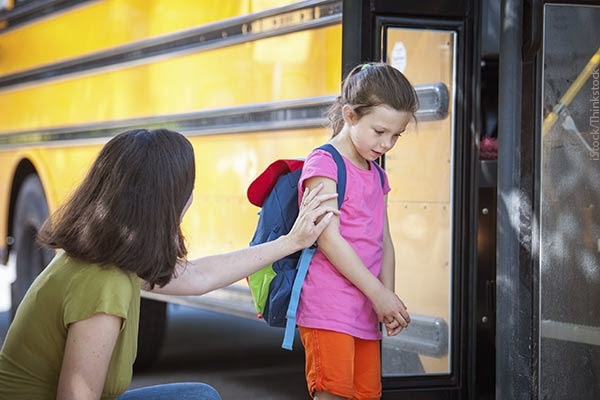Just when you think you and your child have triumphed over her separation challenges, fall arrives and school begins. Your three-year old has spent the last two weeks sobbing and clinging to your leg each morning when you say goodbye at preschool. Or perhaps your kindergartener won’t get dressed, gets distracted by playing with the dog, and you barely get to school on time. Your second grader insists that you walk him to his classroom, even though he was dropped at the curb and walked to class independently by the end of first grade. Or, your 11 year-old who just started middle school lies in bed until you find yourself screaming and threatening to take away TV for a year. He ends up eating a granola bar for breakfast as he peddles off to school, angry and blaming you for ruining his life.
Yes, transitions are hard for all children no matter what their age, but the root of all these behaviors is often separation anxiety. Learning to say goodbye and feeling confident about making their way in the world is an ongoing challenge for most children at each development stage and new transition, continuing into adulthood. As parents, we are often experiencing deep sadness and anxiety ourselves about launching our child into their next phase of maturity and independence, which can make it even harder for our children to build confidence.
The unpredictability of separation anxiety often makes managing it all the more daunting. Your child has happily and enthusiastically said goodbye to you at the last two birthday parties which she attended, yet you are completely baffled when she becomes hysterical and won’t get out of the car at the next one. Equally common is the preschooler who loves school the first two weeks of fall, and then starts refusing to go to school by week three. This is the roller coaster of separation, which is very common for many children at different stages in their lives.
The ability to separate is a learned skill for children whose temperament qualities including sensitivity, lack of flexibility, and being slow to warm-up in new situations. Though they may master the skill at a certain stage of their development, they may need to practice and learn it again as they experience novel situations and expectations. New environments with different rules, new teachers or other adults, and new peer groups all can trigger a fresh bout of separation anxiety for your child. If we add our own concerns about our child’s ability to adjust and be successful in the new situation, we have a perfect recipe for tears and resistance.
Here are five steps to help with separation anxiety:
- The first step in helping your children is to accept that these challenges can come up at any time, and to reassure them that their feelings and fears are normal and healthy.
- For some of us, an important step is also reminding ourselves that whatever new situation our child is facing, we have confidence in ourselves as parents that what we are expecting is appropriate and in our child’s best interest — that every step of letting go is a step towards independence, competence, and confidence for our son or daughter.
- Take the time to prepare your child for new situations by learning as much information as possible about the new situation and by sharing and explaining with them, so they can begin to feel mastery before arriving.
- Let them know that most people feel nervous about new things at first, and remind them of previous situations they have experienced where they felt upset and resistant, but ended up feeling happy and successful.
- And finally, use encouragement and positive language to express our utmost confidence in their ability to not just become comfortable in new situations, but to participate fully and to make a contribution.



